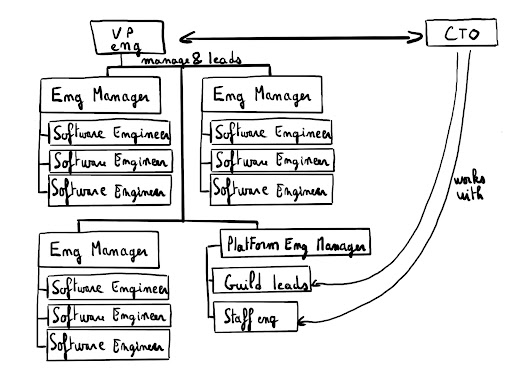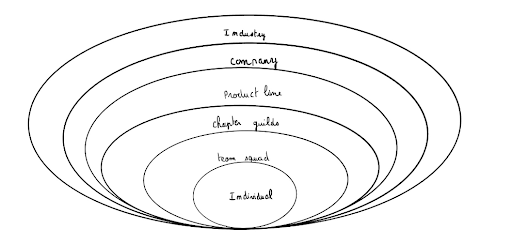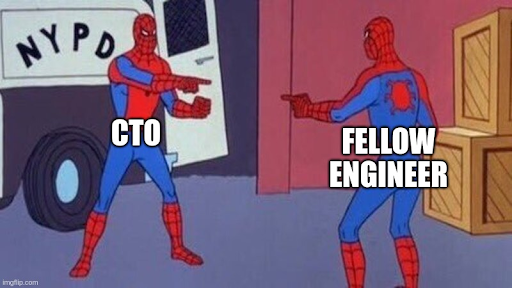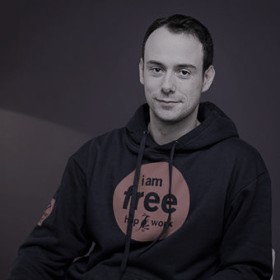This post is a direct sequel to "CTO from startup to scaleup" because in fact... I've chosen not to be a CTO anymore. But I didn't leave Malt and became a Fellow Engineer.
This is of course a very personal post, but you might be interested by the following topics:
- feedback on the role of founding CTO in Scale Up.
- the role of Fellow Engineer as we've defined it at Malt.
CPTO, product leader in a scaleup from 200 to 600 (2021-2022)
The previous post ended in 2021. Our previous CPO had left the adventure in 2020, and I had to take on the role of interim CPTO, sharing the CPO role with Vincent, also co-founder of Malt.
The Product team grew a little over the period, from 50 to 120.
Between 2021 and 2022, the company grew from 200 to 400, then acquired a German company, Comatch, bringing Malt's total workforce to around 600 by the end of 2022.
Let's go back to my role as CPTO until mid-2022.
I'm not going to take any detours. I'm mixed about my results, even though I think some conditions weren't optimal and could have gone better in another context. I'm still learning about myself.
As the co-founder of a start-up, you're always changing hats, and it's important to know how to fire yourself over and over again to recruit someone better than you. I know all about that. Over the years, I've learned to know when it's time to hand over the reins.
As I said in the first post, being a co-founding CTO means first and foremost being the first developer. I find it hard not to get your hands dirty in the early stages of the company. And then, as the company grows, you have to make choices. Some people focus on managing delivery and organization, and their role is similar to that of VP Engineering. Others focus on specific aspects of the product organization: head of data, head of security, architect. Still others become CPO or even COO.
This choice can be made early in the life of a company, but it becomes inevitable in Scale Up.
A Scale Up is by definition a company that needs to... scale up, what a surprise. And that requires people who know how to execute their roles to perfection. At this point, for the good of the company, you need to position yourself on what you do best.
And that's what happened recently. I've come to realize that I'm comfortable with risk-taking, team organization and recruitment, product exploration, prototyping and technology, but that I'm less in my element with people management, long lead times, change management and communication (apart from technology).
Even so, I'm not totally dissatisfied with the result, as it was during this transition period that I helped bring in people to take us to the next level, to the positions of CPO, VP Data, tribe director etc...
Which brings me to the next transition.
From CPTO to CTO again (2022-2023)
3 years ago, Benoit arrived at Malt as VP engineering.
If you're curious, I wrote a blog post to explain why we'd been looking for a VP and how we'd recruited him.
From mid-2022 and the arrival of a new person as CPO, I was able to return solely to the CTO role.
With Benoît we defined the separation of roles between CTO and VP as follows:
We consider that, at Malt, the CTO is responsible for the innovation and use of technologies, while the VP Engineering is responsible for the production carried out by the Engineering team. This is how we might summarize it: vision vs. execution.
But let's take a closer look.
The CTO's mission
For us, the CTO's primary mission is to guarantee innovation and technology. (CTO = Chief Technology Officer).
Innovation is a big word, but it includes actively monitoring and detecting opportunities for using technology to serve the company.
It's the protection and regular supervision of technologies and uses within the company, which we also call governance.
Of course, this is not a solitary role. The CTO works in association with guild leads, the platform team and all staff engineers (and more).
It's an outward-looking role (listening to the outside world and being visible to the outside world).
Innovation includes the development and launch of new products, apart from the main product.
And within Malt, my role in discussions with other functions is above all to detect opportunities and see how best to use technology at Malt.
To give you a few concrete examples over the last few months:
- I was an active driving force behind the API integration between Indy and Malt.
Indeed, creating an API-based use for Malt data is a major technological challenge for the next few years, and this first project laid the foundations.Of course, it's up to the Product Managers to put this into practice. - I diagnosed and initiated the needs and resources required for a major architectural overhaul of our stack. I'm currently leading this project, which will take 2 years from the start of the study to the end of implementation. Technological vision is a long-term process
- I've been involved in evaluating companies' technologies for potential M&A operations, including an acquisition that took place in 2022.
- I carried out technical and product discovery phases on our core bricks (payment) to create a 3-year vision.
The VP's mission
The VP Engineering is the guarantor of everything produced by Engineering at Malt. He's the guarantor of quality, deadlines and, more generally, of the team's state of health.This is a key role, as he is the main boss of Engineering, responsible for executing the product vision.
He works mainly with Engineering managers, who act as relays within the teams.
It's a role focused on people, recruitment, managing individuals and their performance, career development and training. But it's also a technical role that supervises the software quality produced. It's the person who defines standards.
It's the person who works with the CPO to determine how best to optimize the constitution of the teams to achieve the business objectives set.
His or her role is to constantly seek the best organization and allocation of Engineering resources to achieve results in the most efficient way possible.
(For example: whether or not to have a QA team, how to build a platform team, how to articulate communication between a platform team and the product tribes, how to manage resource constraints when working with teams outside the product, such as marketing, etc.).
It's a role that's largely internal. Even if external visibility remains important for recruitment.
When the VP Engineering discusses with other C-Level members or top management, his role is that of facilitator and problem solver.
It's to him that we turn to understand what's coming out, who's working on what, how we're operating the system, etc...
It's also the guardian of financial and legal constraints.
As you can see, it's a central role.In a nutshell, this is how it works:

Warning, I have deliberately omitted many details in this simplified diagram!
CTO and VP, complementary roles
Obviously, these aren't two distinct roles that don't talk to each other.
As CTO, my job is to establish a technological vision.
I work with the VP, whose role is to see how this technological vision can be put into practice. And to do this, he also has the heavy responsibility of implementing the vision of the CPO and other functions (marketing, finance, international, etc.).
At the end of the day, it's the CPO who must have the final say on the use of resources, which means weighing up multiple objectives that are not always easy to compare.
We regularly exchange views on subjects that mix organization and tech vision, such as the handling of technical and functional debt, international expansion and so on.
But we always try to respect this breakdown:
CTO: How are we going to take advantage of technology to solve these issues? What new trends can our business benefit from?
VP: How are we going to implement this vision over time, and with whom?
From CTO to Fellow Engineer (2023-...)
This last year has enabled me to take the lead on some important issues as an individual contributor. The chemistry with our VP Engineering worked very well. He challenged me and helped me through the difficult times. I did the same in the other direction. This complementarity benefited both of us.
After 10 years as CTO, I've decided to focus completely on my role as an individual contributor, in order to make a greater impact within the product team.
My role is now that of Fellow Engineer. This recognizes a level of impact rather than just a level of expertise. I'm certainly not the most expert at Malt.
We introduced this position in Malt's career path a few years ago, without imagining that we'd ever use it.
It's a role that's expected to have an impact on its industry, which I mentioned in a previous post. I hope to have proved my impact on the freelancing industry with the creation of Malt. Although of course, being a Fellow engineer at Malt is still modest compared to being a Fellow Engineer at a larger company like Google or Redhat. It's all relative :)

My missions as a Fellow Engineer are relatively close to those we had defined as the CTO's missions:
- Represent Malt in the freelancing and engineering industry
- Influence and strengthen Malt's technological governance
- Study how to develop technological opportunities for Malt.
One of the differences with my previous role as CTO is that I no longer have any people to manage. A Fellow Engineer, like a Staff or Principal, is characterized by his or her leadership, another form of management based on influence (and his or her track record of success, of course).
And I'm no longer on the management committee, although as co-founder I'm still on the company's board of directors.
All this means that I have fewer requests to concentrate on my role as an individual contributor.
(And incidentally, I hope to receive fewer commercial solicitations on linkedin by changing my title

What's next?
The last post concluded with an opening about the move to Scale Up. It's a little early to have a perspective on what's next. Malt faces many challenges in these turbulent economic times, and I'll do my best to help make it a sustainable business.
See you in a couple of years perhaps for an update?



